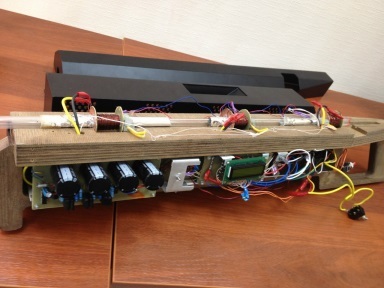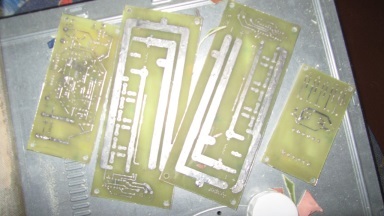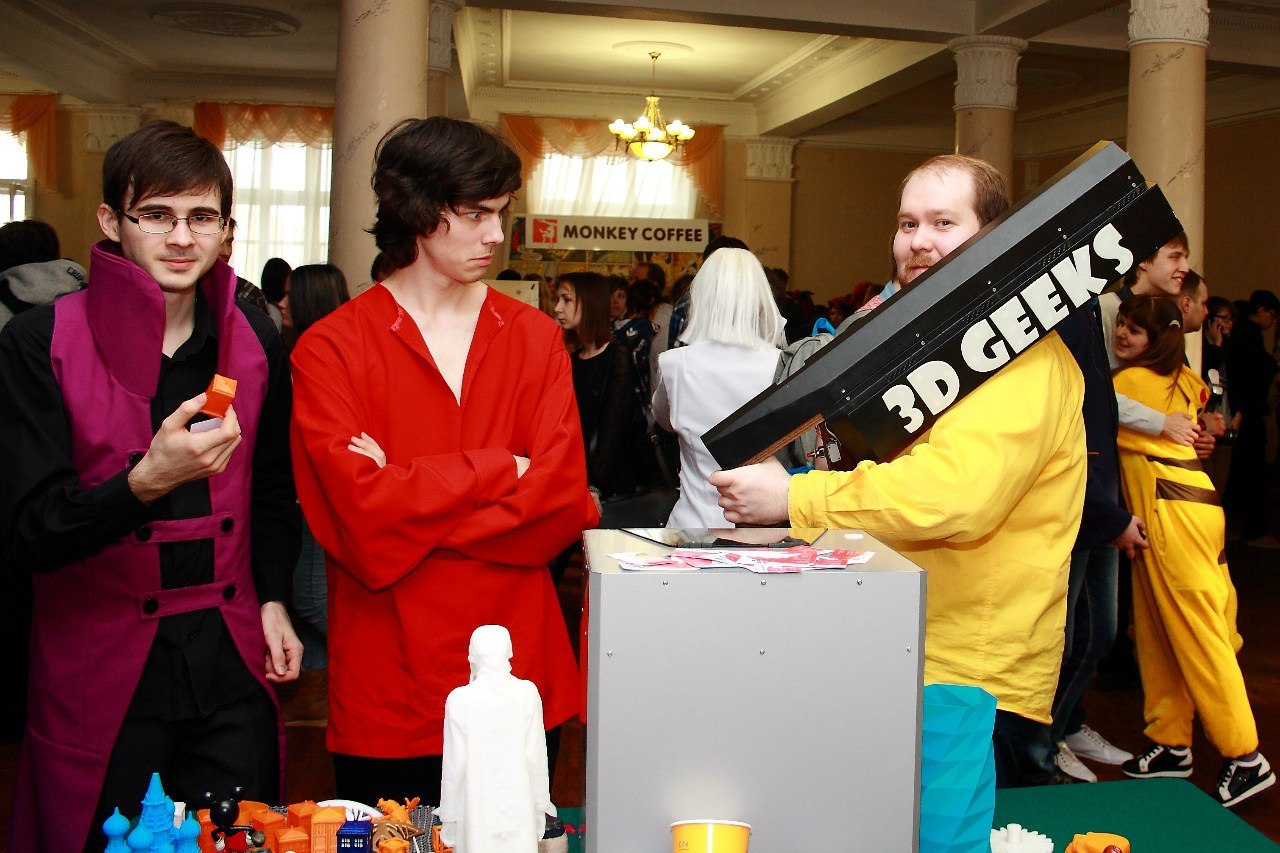Tale of how to make a Gauss gun in seven days

When I was studying at the university in the second year, a very unusual order came to me - a three-step Gauss gun. The deadlines for its creation were very short: there was only a week for everything about everything. In addition, the gun was with a physically unrealizable twist: the polarity reversal of the magnetic field of the coils, which, according to the author of the gun, should increase its efficiency. However, since I loved the Gauss guns and dreamed of starting to make money my favorite thing, I agreed to fulfill the order.
')
On vacation, nothing foreshadowed ...
It was a winter vacation, there was just over a week before the start of study. Nothing foreshadowed strange orders, when suddenly my friend called me and asked if I had a desire to take part in the development of a real Gauss cannon. Of course, I was all for it. Money for a gun promised to allocate as much as you like (meaning to the details, and not to pay for the work). The main condition was to finish the gun on time, she also had to be able to reverse the polarity of the magnetic field of the coils so that the projectile would receive additional acceleration, and also
After reviewing the scheme of the gun, I just fell out,
Another unpleasant surprise was that the body for the gun was ready. Therefore, the location of the coils could not be changed, and their size was limited in length.
As for the reversal of the coils ... I tried to explain that the energy in the coil cannot "disappear into nowhere," nevertheless, this was an important condition, although thanks to my proposal, the implementation of the reversal of the magnetic field became necessary only in the first stage, and the other three worked , as in ordinary Gauss guns.
Start of development. Bridge coil control circuit
It turned out that the team only I knew about electronics at a high enough level. Perhaps that is why the development went on around the clock for a week with breaks for a little sleep, although we, “Slav”, had three people. ("Glory", because the names of all three ended in "glory").
First of all, I had to figure out what would happen in the bridge circuit for switching on the keys when trying to apply voltage to the coil in the opposite direction after the current had already started to flow through it. For these purposes, I used the LTSpice simulator with the necessary element libraries (which I took, like here and here ). I decided to use parallel IGBT transistors as keys. A Google search showed that parallel connection of IGBT transistors in a Gauss gun will work correctly if each transistor has a small additional resistance (from memory like 0.1 - 0.5 Ohm). Without additional resistors, transistors are likely to burn one after the other. Also, for protection against self-induction, each transistor must have a protective diode. Of course, ordinary electrolytes with a capacity of 330 - 470 microfarads and a voltage of 450 volts were used as capacitors. The value of the coil inductance for the simulator was obtained from the calculations of the coils in the FEMM program. IGBT transistors were controlled through specialized opto drivers for this purpose, since galvanic isolation was necessary.
As a result, it turned out that in the bridge circuit during the coil reconnection, transistors had powerful reverse current emissions that were incompatible with the life of silicon. Absolutely nothing solved this problem, and the varistor did not save either. On the other hand, if the transistors were removed along one diagonal and the diodes were left there, an energy recovery circuit was obtained. In the case of recovery, the residual energy of the coil after passing the projectile through it was returned back to the capacitor.
These two news I told the customer. However, the customer said that the reversal must be implemented necessarily, even if you have to sacrifice efficiency (although initially the goal was to increase efficiency). In the end, I just turned on the coil in series with an additional resistor, the value of which was selected based on the permissible values of the reverse current of the transistors.
Coil calculation
Perhaps it was faced with the calculations of the coils for the Gauss guns, I first learned that something can be calculated by the computer for hours, if not all days. As I wrote earlier, the calculation was carried out with the power of a special script in the FEMM program. An acquaintance gave me a “truthful” script for the calculation. If you are interested, you can search the Internet for “coilgun_cu.lua” or download it here while the link is working . There are also two resources ( here and here ), where I read about the same IGBT transistors, and about FEMM and much more.
After completing the calculations with optimization, the values of the projectile velocity, the efficiency of the gun, the number of turns, etc. were obtained. In fact, one cannot call these values the only optimal ones, while choosing the optimization parameters, one has to be guided by technical intuition, so there are no guarantees that these values the best. Most likely they will be the best only in a certain area of parameters of the coils.
Gun control
Since the three-stage gun, the question arises how to switch coils. In order to determine the presence of a projectile in front of the coil, it was decided to use a standard solution in the form of optical sensors (I advise you to buy imported IR LEDs for this purpose, since the old domestic ones consume a lot of energy). It was decided to determine the signals from the sensors using external interrupts of the AVR microcontroller. The microcontroller also measured the voltage on the capacitors and made corresponding sounds at two charge levels: when the capacitors are fully charged and when they are close to full charge (80-90% of the maximum).
Voltage converters
In order to charge capacitors with a total capacity of almost 2000 microfarads to a voltage of 450 volts from a 12 volt battery, a sufficiently powerful converter was needed. I was too lazy to make a converter from scratch, and therefore I simply removed it from my own Gauss gun. Who cares, it was the converter Valdemar .
To power the IGBT gates of the transistors of the upper part of the bridge, it was necessary to have a galvanically isolated voltage, which I decided to get using the usual generator blocking. As a result, another voltage converter was added to the gun.
Creation of printed circuit boards
At that time, I used Sprint-Layout to create printed circuit boards. This program is very easy to learn and use, for small projects is the fact.
Having painted all the diagrams, I printed them on glossy paper and then ironed the images onto a prepared sheet of fiberglass plastic with copper one-sided coating. Then there were only the boards to be etched, tinned, then the parts were soldered ... And so with all the 5 boards.
Boarding boards

Reversal board

Build and test
Putting it all together, I got something to water this:

And the very first testing showed the inconsistency of the idea with coil polarity reversal. The transistors burned even with a large additional resistance, and the efficiency at the same time fell so low that the projectile “rolled out” of the gun. If the projectile did not roll out, but flew out, the transistors were enough for a maximum of five shots. As a result, I suggested leaving the polarity reversal only externally, and on the reverse side of the board we should redo the scheme so that the work of the first stage of the gun did not differ from the work of the other two stages.
In any case, energy recovery worked, and it was noticeable (at least one plus from the use of a bridge circuit for coils).
The efficiency of the gun remained ultimately unknown. However, during one of the testing of the gun, I underestimated its power, and a shell
Total.
The customer was completely satisfied with the result. We received the money (I must say, now I understand that it was not enough for such work) and we divided what we
Later, I found my brainchild in one business incubator, where she lay for beauty. It was also shown at one festival, however, at that time it was already in non-working condition.
Photos from the festival Animau 2015

Source: https://habr.com/ru/post/306388/
All Articles